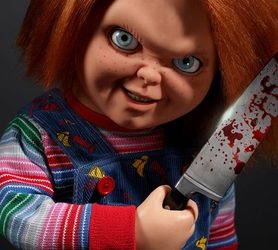The bloody mantra of the Child’s Play franchise reigns true in the new SYFY television series—“A true classic never goes out of style.”
The knife-wielding doll, possessed by the soul of a serial killer, made his small screen debut in this fall’s Chucky series on Syfy. The pilot, “Death by Misadventure,” tackled the peculiar challenge of satisfying rabid fans while welcoming new viewers.
The series is a direct continuation to the seven prior Child’s Play/Chucky films. Creator Don Mancini teased the return of a rogue’s gallery of Chucky friends-to-the-end, and the pilot provided a surprisingly accessible introduction to the franchise lore.
The pilot sees gay protagonist Jake Wheeler (Zackary Arthur) navigate the close-minded town of Hackensack, complete with school bully Lexy Cross (Alyvia Alyn Lind), love interest Devon Evans (Björgvin Arnarson), and brooding cool kid Junior Wheeler (Teo Briones).
The episode kicks off as Jake purchases everyone’s favorite Good Guy doll with a bad streak Chucky (Brad Dourif) at a yard sale. As the pilot unravels, Jake slowly discovers the nature of the plastic menace, climaxing with the strobe-lit death of his homophobic father at the tiny hands of the titular toy.
The pilot bursts with personality and outrageous scenes that would feel right at home in a tongue-in-cheek ’80s slasher. Chucky swallows a bottle of liquor and vomits onto a man’s legs; Jake makes googly eyes at a horror podcaster; Jennifer Tilly makes the least subtle cameo since Alfred Hitchcock in any of his movies; and a high school bully is roasted with Pokémon porn allegations at a high school talent show.
The Chucky series brings to the blood-soaked table a seldom-granted need: positive queer representation in horror. Fans of the macabre are inundated with homophobic and transphobic genre staples. Namely, the “man in a dress murderer” trope present in classics like Psycho, The Silence of the Lambs, Dressed to Kill, and Sleepaway Camp.
With a sympathetic and charismatic queer front man in 14-year-old Jake, young queer kids will connect with the show—no doubt watching under the safety of a warm blanket—and older queer fans will relish its explicit embrace of queerness.
Horror is inextricably tied with queerness. Openly gay genre pioneer James Whale directed seminal early works in 1930’s Frankenstein, The Bride of Frankenstein, and The Invisible Man. Author Anne Rice revolutionized the vampire with her long-running queer series The Vampire Chronicles, and queer British novelist Clive Barker brought London’s gay bondage scene to the big screen with the Hellraiser franchise.
But throughout horror history, time and haunted time again, queerness is sequestered to subtext. Despite how obvious the homoeroticism is in celebrated films like 1994’s Interview With The Vampire and 1985’s Nightmare On Elm Street II, a character’s queer identity is never discussed out loud or explicitly confirmed.
Even in more recent spooky outings, queer viewers are robbed of their favorite gore-dripping stars stating their queerness in transparent terms.
2019’s Bit with Nicole Maines marked the first time a transgender woman starred in a horror film (the first trans woman to star in a horror television show happened first with Angelica Ross in American Horror Story: 1984). Though Maines’ presence was certainly a triumph, and her acting was delightfully charming, Bit never stated her character’s trans status in plain English.
I write all this to say that Chucky and its queer creator portray Jake’s sexuality in honest and open terms. And the results are more refreshing than an ice-cold blood bath. Mancini proved that even in the age of endless “Conjuring” sequels and desolate theater seats, you can’t keep a Good Guy down.


